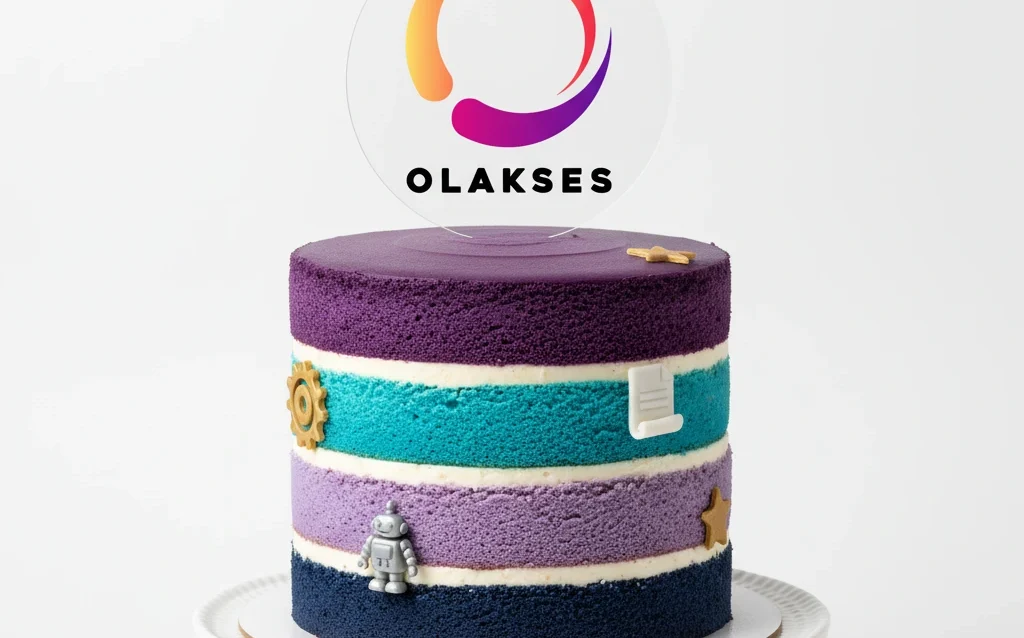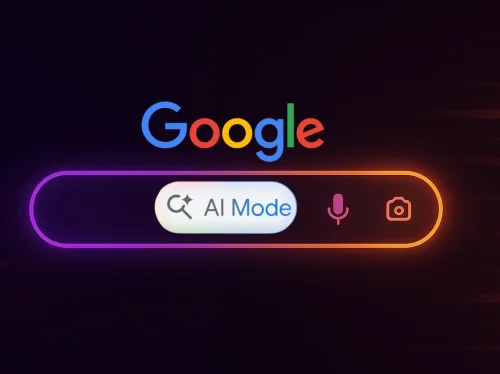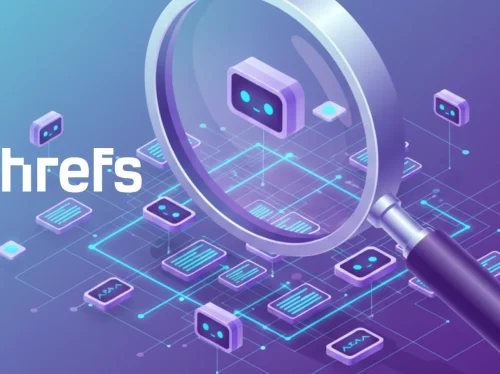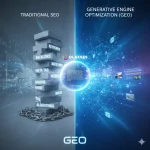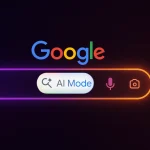Pertanyaan salah yang akan ditanya di 2026: “SEO atau GEO?”
Itu pertanyaan terburuk yang masih beredar di industri digital marketing tahun ini. Bukan karena pertanyaannya gak penting, tapi karena framingnya sudah salah dari awal.
Jawabannya bukan “atau”—tapi “dan”.
Brand yang menang di 2026 adalah yang paham satu hal krusial: GEO bukan pengganti SEO.
GEO adalah evolusi yang butuh fondasi SEO yang kuat untuk bekerja maksimal. Ini bukan soal memilih—ini soal layering.
Artikel ini akan breakdown Layer Cake Strategy ala Olakses: framework 4-layer yang memastikan brand kamu visible di traditional search dan AI-generated answers.
Praktis, terukur, sustainable.
TL;DR – Bottom Line Up Front:
- GEO tanpa fondasi SEO yang solid = strategi rapuh yang akan collapse
- Layer Cake Strategy = pendekatan bertahap (Foundation → Content → GEO → Authority)
- 90 hari untuk full implementation dengan roadmap jelas
- Data-backed framework: Gartner prediksi 25% penurunan traditional search, tapi AI-assisted search akan pengaruhi 50%+ consumer queries—kuncinya adalah menguasai keduanya.
Mengapa “SEO vs GEO” Adalah Framing yang Salah
Kesalahan Fatal: Menganggap GEO Pengganti SEO
Bayangkan kamu mau bangun gedung bertingkat. Apa yang terjadi kalau langsung bikin lantai 2 tanpa fondasi? Collapse.
Begitu juga GEO tanpa SEO.
Realitanya, hanya 20% dari halaman top-ranking untuk query kompetitif yang secara konsisten di-cite dalam AI-generated responses.
Ini bukan kebetulan. AI search engines masih rely heavily pada traditional search index sebagai filter pertama.
Google masih mendominasi dengan 417 miliar pencarian per bulan. ChatGPT memproses 72 miliar pesan per bulan.
Bukan salah satu yang menang, keduanya tetap dominan. Dan mereka bekerja dengan cara yang saling bergantung.
Realita: GEO Adalah SEO 2.0
Mari kita luruskan: GEO extends SEO, bukan replace.
Think of it this way:
- Traditional Search = Discovery layer (orang nemuin brand kamu)
- AI Search = Answer layer (AI recommend brand kamu)
Keduanya butuh satu sama lain.
Tanpa SEO yang solid, konten kamu gak akan masuk database yang di-crawl AI.
Tanpa GEO optimization, konten bagus kamu gak akan di-cite walaupun ranking tinggi.
Data Point: Revenue dari AI-driven search engines melonjak 525% antara Januari dan Agustus 2024. Tapi ini gak berarti SEO mati. Ini berarti ada additional layer yang harus dikuasai.
47% brand masih belum punya strategi GEO yang deliberate—itu opportunity window. Brand yang act now akan dominate visibility.

SEO vs GEO: Apa Bedanya?
Perbandingan Head-to-Head
| Aspek | SEO | GEO |
|---|---|---|
| Goal Utama | Ranking tinggi di SERP | Di-cite di AI-generated answers |
| Success Metric | CTR, organic traffic, ranking position | Citation frequency, zero-click satisfaction |
| Primary Signals | Keywords, backlinks, Core Web Vitals | Content clarity, statistics, expert quotes, structure |
| Output Type | List of clickable links | Direct synthesized answer (multimodal) |
| User Journey | Click to website → explore | Get answer in platform (may not click) |
| Content Optimization | Long-form, keyword-optimized | Snippet-friendly, cite-ready structure |
| Time to Result | 3-6 months | 3-6 months (similar!) |
| Tools | Google Search Console, Semrush, Ahrefs | Ahrefs Brand Radar, Semrush AI SEO, manual AI checks |
Kenapa Keduanya Penting di 2026?
Data speaks louder than opinions:
- Adoption Rate Meningkat Drastis
Jumlah US users yang pakai AI sebagai primary search tool akan mencapai 36 juta di 2028, naik dari 15 juta di 2024. Growth rate 140% dalam 4 tahun.
- Adoption Rate Meningkat Drastis
- Search Behavior Berubah
Gartner memprediksi penurunan 25% volume pencarian tradisional pada 2026, bukan karena orang berhenti search—tapi karena search behavior evolve.
- Search Behavior Berubah
- AI Citation ≠ SEO Ranking
Research dari Princeton menunjukkan bahwa expert quotes meningkatkan AI visibility sebesar 41%, sementara statistics dan inline citations masing-masing memberikan peningkatan 30%. Ini signals yang berbeda dari traditional SEO.
- AI Citation ≠ SEO Ranking
- Zero-Click Reality
Estimated over 50% of searches akan jadi “zero-click” pada 2026—users dapat jawaban tanpa visit website. Tapi ini bukan bad news kalau brand kamu yang di-cite.
- Zero-Click Reality
Bottom line: Ignore salah satunya = kehilangan market share.

The Layer Cake Strategy: Framework 4-Layer
Strategi layer cake adalah pendekatan bertahap yang memastikan setiap layer mendukung layer di atasnya. Tanpa Layer 1, Layer 4 akan collapse.
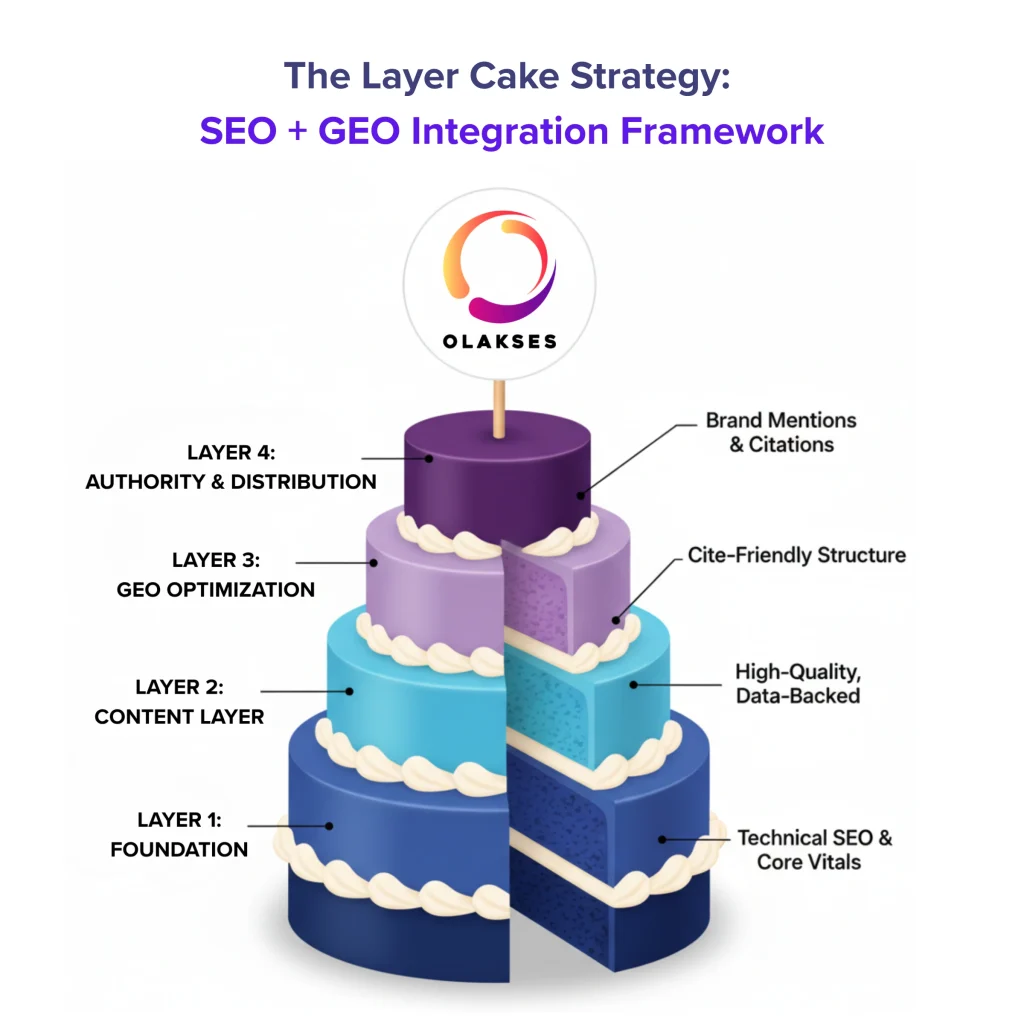
Mari kita breakdown setiap layer.
Layer 1 – Foundation: Technical SEO & Core Web Vitals
Mengapa ini base layer:
AI engines masih rely pada traditional crawling mechanisms.
Tanpa indexing yang proper, konten kamu gak akan masuk database AI.
Site speed dan mobile-friendliness adalah trust signals. bukan cuma untuk Google, tapi juga untuk AI yang evaluate source credibility.
Research menunjukkan bahwa 63% users trust AI-generated content ketika sourcenya credible. Dan kredibilitas dimulai dari technical health.
Actionable Checklist:
Crawlability & Indexing
- Robots.txt properly configured (allow AI bots: GPTBot)
- XML sitemap updated dan submitted
- No orphan pages (semua pages terhubung via internal links)
- Fix broken links & 404 errors
Core Web Vitals
- LCP (Largest Contentful Paint) < 2.5s
- FID (First Input Delay) < 100ms
- CLS (Cumulative Layout Shift) < 0.1
- First page of Google captures 71% of search traffic clicks—speed matters
Security & Trust
- HTTPS implemented (SSL certificate)
- Secure payment gateways (kalau e-commerce)
- Privacy policy & terms clearly accessible
Structured Data / Schema Markup
- Article schema (headline, author, date published)
- FAQ Page schema untuk Q&A sections
- Organization schema (brand identity)
- Breadcrumb list schema (navigation clarity)
Mobile-First Indexing
- Responsive design (bukan separate mobile site)
- Touch-friendly navigation
- Readable text size (16px minimum)
- Adequate spacing between clickable elements
Tools untuk Audit:
- Google Search Console (crawl errors, mobile usability)
- PageSpeed Insights (Core Web Vitals)
- Screaming Frog SEO Spider (technical audit)
- Schema.org validator (structured data check)
Layer 2 – Content Layer: High-Quality, Original, Data-Backed
Mengapa ini critical:
Content quality adalah filter utama untuk AI citation.
E-E-A-T (Experience, Expertise, Authoritativeness, Trustworthiness) bukan cuma ranking factor SEO—ini juga core evaluation criteria untuk AI models.
Content Quality Standards:
Original Research & Data
- Bukan cuma aggregation, create new insights
- Proprietary surveys, studies, atau analysis
- Original quotes from industry experts
- Case studies dengan real results
Long-Form Comprehensive Content
- Pillar content: 2,000-4,000+ words
- Cover topic exhaustively (jangan surface-level)
- Answer related questions (semantic SEO)
- Link to supporting content (topic clusters)
Clear Problem-Solution Framework
- Identify pain point explicitly
- Explain “why” sebelum “how”
- Step-by-step implementation
Expert Voices & Authority
- Bylines with author credentials
- Quotes from recognized industry leaders
- References to academic research
- Real-world examples & case studies
Content Freshness
- Regular updates (quarterly recommended)
- Add new data as available
- Update stats with latest figures
- Refresh examples for relevance
Content Format Priorities:
Berdasarkan data bahwa 32.5% semua sources yang di-cite AI adalah comparative listicles, prioritaskan format ini:
- Comparison Articles (“X vs Y”, “Best of”)
- How-To Guides (step-by-step, actionable)
- Data Studies (original statistics, benchmarks)
- Listicles (“Top 10”, “7 Ways”)
- Ultimate Guides (comprehensive resources)
Layer 3 – GEO Optimization: Cite-Friendly Structure
Mengapa ini game-changer:
Konten bagus tapi gak structured = gak akan di-cite.
AI butuh clarity, bukan complexity. Ini layer yang transform “good content” menjadi “AI-citable content”.
GEO Framework: 5 Core Rules
1. Position Bias → Jawaban Inti di Awal
AI models heavily favor content di early positions. Jawaban harus muncul dalam 3-4 paragraf pertama.
Bad Example:
“In this article, we’ll explore various aspects… First, let’s understand the history… Then we’ll dive into…” [Jawaban baru muncul di paragraph 10]
Good Example:
“GEO needs SEO foundation. Layer 1 must be solid before Layer 4. Here’s why: [direct answer]” [Immediately actionable]
2. Low Perplexity → Kalimat ≤15 Kata
AI lebih mudah parse sentences yang short dan clear. Target: 80%+ sentences ≤15 words.
High Perplexity (Avoid):
“The implementation of generative engine optimization strategies, while maintaining traditional search engine optimization best practices, requires comprehensive understanding of algorithmic preferences and user intent alignment across multiple platforms simultaneously.” [45 words = too complex]
Low Perplexity (Better):
“GEO needs SEO as foundation. Both work together. Start with technical SEO first. Then layer GEO tactics. This creates sustainable visibility.” [5 sentences, avg 6 words each]
3. Statistics Integration → Data di Every Section
Numbers make content cite-worthy. Minimum 1 statistic per major section.
Format Template:
According to [Source + Year], [Specific Stat + Context].
Example:
According to Gartner (2024), traditional search volume will drop 25% by 2026 due to AI adoption.
4. Quotation Addition → Expert Authority
Direct quotes from recognized experts boost credibility signals AI evaluates.
Format:
“[Quote]” – [Name, Title, Company]
Atau cite research:
As [Princeton researchers / Gartner / etc.] found, [finding].
5. Fluency Optimization → Natural, Conversational
Hindari overly formal academic tone. Write like you’re explaining to smart colleague.
Stiff (Avoid):
“It is imperative that organizations prioritize…”
Conversational (Better):
“Brands need to focus on…”
Structure Tactics untuk AI-Citability:
- Descriptive Headers (Question-Based)
❌ Bad: “Implementation”
✅ Good: “How to Implement Layer Cake Strategy” - TL;DR Boxes
Add summary boxes at start of major sections. - Bullet Lists & Numbered Steps
Break down complex processes. - FAQ Sections
Direct Q&A format = featured snippet magnet. - Tables & Comparison Charts
Visual data = easier for AI to extract. - Clear Citations with Hyperlinks
Link every statistic to original source.
Layer 4 – Authority & Distribution: Brand Mentions & Citations
Mengapa ini multiplier:
AI algorithms prioritize brand mentions over traditional links. Third-party validation adalah trust booster massive untuk AI evaluation.
Authority Building Strategies:
1. Digital PR untuk Brand Mentions
Tactics:
- Press releases di authoritative sites (TechCrunch, Kompas.com, IDNTimes dan media kredibel lainnya)
- Guest posts di high-DA publications (contribute expertise)
- Partnerships dengan respected brands (co-marketing)
- Awards & accreditations (third-party validation)
- Speaking engagements (conferences, webinar, podcasts)
Why It Works:
Research menunjukkan brand yang appear di well-ranked list articles punya highest likelihood di-cite oleh generative AI.
2. Review & Reputation Management
Critical Threshold:
Minimum rating 3.5/5 stars. Below this = unlikely AI citation.
Action Items:
- Monitor reviews across platforms (Google, Trustpilot, G2, Capterra)
- Respond to reviews actively (show engagement)
- Showcase testimonials & case studies on site
- Address negative feedback constructively
3. Directory & Database Listings
Target:
- Industry-specific directories (niche authority)
- Google Business Profile (local SEO + AI)
- Crunchbase, LinkedIn Company Page (company data)
- Software review sites if applicable (G2, Capterra)
Format Tip:
Cite company achievements in descriptions (size, customer base, awards).
4. Content Distribution Strategy
Channels:
- Repurpose blog content into LinkedIn articles
- Medium cross-posting (canonical tag to original)
- Industry newsletter features
- Reddit/Quora value-add answers (with links)
- Twitter/X threads (awareness + backlinks)
- YouTube video versions (multimodal presence)
Amplification:
- Email newsletter to subscribers
- Social media organic + paid
- Influencer partnerships (mention/share agreements)
- Community engagement (Discord, Slack groups)
Implementasi Praktis: Roadmap 90 Hari
Teori tanpa eksekusi = sia-sia.
Ini step-by-step roadmap untuk implement Layer Cake Strategy Olakses dalam 90 hari.
Month 1 – Audit & Foundation (Layer 1)
Week 1-2: Technical SEO Audit
Tasks:
- Run full site audit dengan Screaming Frog
- Check Google Search Console untuk crawl errors
- Core Web Vitals assessment via PageSpeed Insights
- Identify & prioritize technical issues
Deliverables:
- Technical health scorecard (prioritized fix list)
- Core Web Vitals baseline metrics
- Crawl error log with solutions
Tools:
- Screaming Frog SEO Spider
- Google Search Console
- PageSpeed Insights
Week 3-4: Content Audit & E-E-A-T Assessment
Tasks:
- Inventory all existing content (blog, pages, resources)
- Evaluate content quality (E-E-A-T signals)
- Identify top performers (traffic, engagement, conversions)
- Map content gaps vs competitor analysis
- Check for thin/duplicate content
Deliverables:
- Content inventory spreadsheet
- Top 10 high-potential pages for optimization
- Content gap analysis report
- Author bio & credential audit
Questions to Ask:
- Does content demonstrate experience?
- Are authors credentialed experts?
- Is brand authoritative in niche?
- Are facts verifiable & sourced?
Month 2 – Content Optimization (Layer 2 & 3)
Week 5-6: Update Existing High-Value Content
Tasks:
- Take top 10 pages from audit
- Add GEO structure (position bias, low perplexity)
- Integrate statistics with external links
- Add expert quotes atau research citations
- Create TL;DR boxes at section starts
- Implement FAQ sections
- Add comparison tables where relevant
- Update author bios with credentials
Deliverables:
- 10 fully optimized pages
- Before/after metrics baseline
- Internal linking update
Week 7-8: Create New Cite-Friendly Content
Focus Formats:
- 2-3 comparison articles (“X vs Y”)
- 1 comprehensive guide (3,000+ words)
- 1 original data/research piece (if possible)
Requirements Per Piece:
- Layer Cake principles applied
- 5+ statistics with sources
- Comparison table atau visual aid
- FAQ section (minimum 5 questions)
- Schema markup (Article + FAQPage)
- Internal links to 3+ related pieces
- External citations to 5+ authority sources
Month 3 – Authority Building (Layer 4)
Week 9-10: Outreach & Brand Mentions
Tasks:
Digital PR Campaign:
- Pitch 10+ industry publications (guest post or feature)
- Create newsworthy angle (original research, trend analysis)
Directory Submissions:
- Submit to 10+ relevant directories
- Update Google Business Profile (complete info + posts)
- Optimize LinkedIn Company Page
Influencer Outreach:
- Identify 20 industry influencers
- Personalized outreach (share + comment request)
- Build genuine relationships (not transactional)
Deliverables:
- 5+ secured brand mentions
- 10+ directory listings live
- Outreach tracker with responses
Week 11-12: Monitor, Measure, Iterate
Tasks:
AI Citation Tracking:
- Manual checks: Query ChatGPT, Perplexity, Gemini with target keywords
- Document: Which content gets cited? By which platform?
- Tool: BrightEdge AI Overview tracking (if budget allows)
Traditional SEO Metrics:
- Google Search Console: Impressions, CTR, rankings
- Google Analytics: Traffic, engagement, conversions
- Semrush/Ahrefs: Backlink profile, keyword rankings
Performance Analysis:
- Which tactics worked best?
- Content gaps still exist?
- AI citation patterns emerging?
Iteration Plan:
- Double down on winning formats
- Update underperforming content
- Plan next 90-day cycle
Deliverables:
- Comprehensive performance report
- AI citation baseline (frequency by platform)
- Iteration roadmap for next quarter
Tools & Metrics: Cara Measure Success GEO + SEO
SEO Metrics (Traditional)
Traffic & Engagement:
- Organic traffic (Google Analytics)
- Pages per session
- Average session duration
- Bounce rate
- Scroll depth
Rankings:
- Keyword positions (Semrush, Ahrefs)
- Featured snippet ownership
- “People Also Ask” appearances
- SERP feature wins (video, images, etc.)
Authority:
- Domain Rating (Ahrefs metric)
- Backlink profile (quantity + quality)
- Referring domains (unique sources)
- Brand mention volume
Technical:
- Core Web Vitals scores
- Crawl error rate
- Index coverage (Google Search Console)
- Mobile usability issues
GEO Metrics (Emerging)
AI Citation Tracking:
Manual Method:
- Create query list (20-50 target queries)
- Test each in ChatGPT, Perplexity, Gemini
- Document: Brand mentioned? Content cited? Link included?
- Calculate citation frequency: (Citations / Total Queries) × 100
Tools for GEO Tracking:
- Ahrefs Brand Radar – Tracking across keywords
- Semrush AI Overview – Track visibility in AI-generated results
Key GEO Metrics:
- Citation Frequency – % of target queries where brand appears in AI answer
- Citation Position – Primary source vs secondary mention
- Brand Mention Volume – Track mentions across web
- Sentiment Analysis – Positive / Neutral / Negative ratio
- Share of Voice (AI Context) – Your brand vs competitors in AI responses
Kesalahan Umum yang Harus Dihindari
❌ Kesalahan #1: All-In GEO, Abandon SEO
Kenapa Bahaya:
- Technical foundation collapse
- Indexing issues → konten gak masuk AI database
- Lost traditional search traffic (still majority!)
Solusi:
Maintain Layer 1 (foundation) terus-menerus. Technical SEO bukan “set and forget”—ini ongoing maintenance.
❌ Kesalahan #2: Keyword Stuffing untuk GEO
Kenapa Gak Work:
Princeton research explicitly menunjukkan keyword stuffing performs worse di GEO. AI models detect unnatural language patterns.
Solusi:
Focus pada natural language dan semantic relevance. Write for humans first, optimize for machines second.
❌ Kesalahan #3: Ignore Brand Reputation
Kenapa Krusial:
AI heavily weights brand sentiment. Negative reviews, bad press, controversy = lower citation likelihood.
Solusi:
- Active reputation management
- Respond to reviews (positive AND negative)
- Address customer complaints publicly & professionally
- Build positive sentiment across platforms
❌ Kesalahan #4: Create Content Tanpa Structure
Kenapa Gagal:
Long-form content bagus tapi gak scannable = AI skip. Wall of text tanpa headers, bullets, atau tables gak AI-friendly.
Solusi:
- Descriptive H2/H3 headers every 300-500 words
- Bullet lists untuk key points
- Tables untuk comparisons
- TL;DR boxes untuk complex sections
- Visual aids (infographics, charts)
❌ Kesalahan #5: Gak Update Content Regularly
Kenapa Problem:
Freshness = major ranking factor untuk SEO & GEO. Stale data = lower trust signals.
AI models continuously retrain on fresh data. Outdated content gets phased out.
Solusi:
- Quarterly content refresh schedule
- Update statistics dengan latest figures
- Add new sections untuk emerging trends
- Refresh examples for current relevance
- Track content performance → prioritize updates
FAQ: SEO vs GEO 2026
Q1: Apakah SEO masih relevan di 2026?
Ya, sangat relevan.
Google masih process 417 miliar searches per bulan. First page of Google captures 71% of search traffic clicks.
SEO adalah fondasi yang memungkinkan GEO bekerja efektif. AI search engines masih rely pada traditional search index untuk sourcing.
Tanpa SEO yang solid, konten kamu gak akan masuk database yang AI query.
Q2: Berapa lama waktu untuk melihat hasil GEO?
Typical timeline 3-6 bulan, mirip dengan traditional SEO.
GEO butuh authority building yang gak instant. Brand mentions, citations, dan reputation signals accumulate over time.
Early wins possible (1-2 bulan) untuk low-competition queries, tapi sustained visibility butuh consistent effort.
Milestone Expectations:
- Month 1-2: Technical foundation & content optimization
- Month 3-4: First AI citations appear
- Month 5-6: Consistent citation rate established
- Month 6+: Compound effect (authority snowball)
Q3: Apakah saya harus pilih antara SEO atau GEO?
Tidak. Ini bukan either/or situation.
Strategi terbaik adalah layer keduanya. GEO without SEO foundation akan gagal karena:
- Konten gak ter-index properly
- Technical issues block AI crawlers
- Lack of authority signals
SEO without GEO = missed opportunity di AI search yang akan pengaruhi 50%+ consumer queries.
Answer: SEO + GEO together. Layer Cake Strategy memastikan both work in harmony.
Q4: Tools apa yang paling penting untuk GEO?
Essential tools:
For Citation Tracking:
- Manual checks (ChatGPT, Perplexity, Gemini, Claude)
- Ahrefs Brand Radar & Semrush AI SEO
For Brand Monitoring:
- Google Alerts (mentions)
- BrandWatch atau Mention (sentiment analysis)
- ReviewTrackers (reputation management)
Q5: Apakah backlink masih penting di era GEO?
Ya, tapi brand mentions juga critical.
Research menunjukkan AI algorithms prioritize brand mentions over traditional links. Tapi ini gak berarti backlinks irrelevant.
Hierarchy of Authority Signals:
- High-quality backlinks (DA 70+, contextual, editorial)
- Brand mentions in authoritative content
- Citations in AI-trusted sources (academic, government, major media)
- Social proof (reviews, testimonials, case studies)
- Industry awards & accreditations
Strategy: Pursue both backlinks AND brand mentions. Quality over quantity tetap rule #1.
Q6: Berapa budget yang dibutuhkan untuk implement SEO + GEO?
Depends on scale dan approach:
Small Business / Startup:
- DIY with tools: $200-500/month (tools only)
- Freelancer/consultant: $1,000-3,000/month
- Small agency: $3,000-7,000/month
Mid-Market:
- In-house team + tools: $5,000-15,000/month (salaries + tools)
- Full-service agency: $7,000-20,000/month
Enterprise:
- Dedicated team + premium tools: $15,000-50,000+/month
- Enterprise agency partnership: $20,000-100,000+/month
Budget Allocation Recommendation:
- 60% traditional SEO (foundation)
- 30% GEO-specific tactics (structure, citations)
- 10% experimentation & new platforms
ROI Timeline:
Most brands see positive ROI by month 6-9 dengan consistent execution.
Q7: Apakah GEO berlaku untuk semua industri?
Ya, tapi tactics vary by domain.
Princeton research menunjukkan different domains benefit dari different optimizations:
Tech & Finance: Statistics addition = highest impact
Arts & Humanities: Quotations from authorities = most effective
Law & Government: Citations to official sources crucial
Science & Healthcare: Peer-reviewed research citations essential
Business & Marketing: Case studies + statistics combination
Bottom line: Core principles apply universally, tapi implementation details adapt by vertical.
Kesimpulan: Future-Proof Strategy 2026
“SEO vs GEO” bukan pertanyaan yang tepat.
Yang benar: SEO + GEO = setuju?
The Layer Cake Strategy memastikan brand Anda visible di traditional search dan AI-generated answers.
Key Takeaways:
- Layer 1 (Foundation): Technical SEO = fondasi non-negotiable
- Layer 2 (Content): High-quality, data-backed content = filter untuk visibility
- Layer 3 (GEO Optimization): Cite-friendly structure = AI-citability
- Layer 4 (Authority): Brand mentions + distribution = multiplier effect
The Data Tells the Story:
47% brand belum punya strategi GEO—itu opportunity window yang closing fast. 36 juta users akan rely on AI search di 2028. Gartner prediksi 25% decline traditional search volume di 2026.
Brand yang act now akan dominate visibility di both channels.
2026 bukan soal SEO atau GEO.
Ini soal brand yang paham cara layer keduanya dengan strategic dan sustainable approach.
Ready to Implement Layer Cake Strategy?
Di Olakses, kami bantu brand implement Layer Cake Strategy dengan data-driven approach.
Dari technical audit sampai content optimization dan authority building, semua dalam satu ecosystem.
Kami Specialize Dalam:
- Technical SEO Foundation – Crawl errors, Core Web Vitals, structured data
- GEO-Optimized Content – Cite-friendly structure, statistics integration, expert quotes
- AI Citation Tracking – Monitor visibility across ChatGPT, Perplexity, Gemini
- Authority Building – Digital PR, brand mentions, directory optimization
- Performance Analytics – Custom dashboards untuk SEO + GEO metrics
Book 30-Minute Free Consultation:
[Schedule Your Strategy Call]

